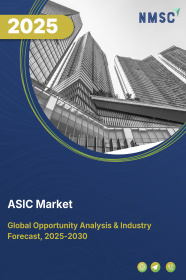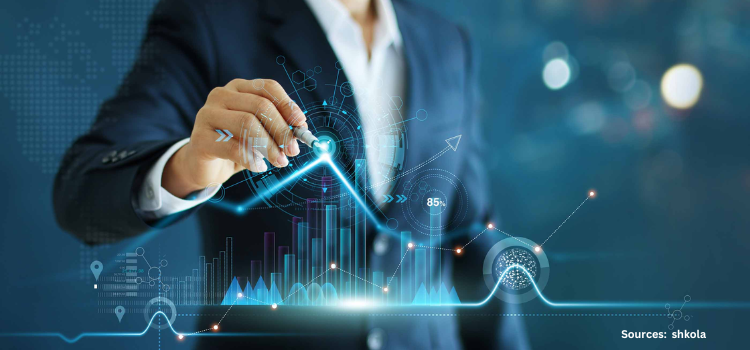
Smart Sensors Market by Type (Level Sensors, Temperature Sensors, Pressure Sensors, Infrared Sensors, and Others), by Components (Amplifiers, Transducers, Analog Filters, and Others), by Technology (MEMS and CMOS), and by End-Users (Residential, Commercial, and Industrial) – Global Opportunity Analysis and Industry Forecast, 2024 – 2030
US Tariff Impact on Smart Sensors Market
Trump Tariffs Are Reshaping Global Business
Smart Sensors Market Overview
The global Smart Sensors Market size was valued at USD 45.52 billion in 2023 and is predicted to reach USD 150.10 billion by 2030 with a CAGR of 18.2% from 2024-2030.
The smart sensors market also known as intelligent sensors includes advanced sensors equipped with processing capabilities that detect physical inputs such as temperature, pressure, motion, or light while simultaneously analyzing and transmitting the data for real-time decision-making.
These sensors integrate microprocessors, embedded software, and communication technologies, making them highly efficient for use in automation, IoT applications, and connected systems across industries such as automotive, healthcare, industrial, and consumer electronics.
The importance of intelligent sensors lies in their ability to improve operational efficiency, enable predictive maintenance, and enhance data-driven insights. The industries move towards greater automation and connectivity making these sensors pivotal in driving innovation and performance improvements across a wide array of applications.
Market Dynamics and Trends
The growing adoption of Internet of Things (IoT) technology globally fuels the smart sensors market demand due to the increasing need for real-time data collection and monitoring across various applications. These sensors enable devices to gather, transmit, and analyze data seamlessly, enhancing efficiency and decision-making in sectors such as healthcare and manufacturing.
According to the report published by 5G Americas in 2024, the global IoT subscription accounts to 3.3 billion in 2023 and is projected to reach 5 billion by 2028, representing a remarkable increase of 52% over a four-year period. This surge in IoT subscriptions highlights the increasing reliance on these sensors to enhance operational capabilities and drive innovation across multiple industries.
Moreover, the rising electric vehicle (EV) sale worldwide due to demand for advanced monitoring and control systems fuels the market growth as these sensors enhance vehicle performance and safety features by providing real-time data on various parameters, such as temperature and pressure.
According to the data published by the International Energy Agency in 2024, the global EV car sale rose from 10.2 million in 2022 to 13.8 million in 2023, reflecting a growth of 35.3% within a span of one year. The significant growth in EV sales emphasizes the essential contribution of advanced sensors in enhancing vehicle performance and safety features.
Furthermore, the rising adoption of wireless sensor networks in semiconductor industry fuels the market growth due to the increasing need for precise, real-time monitoring and automation in manufacturing processes. These sensors enhance production efficiency, optimize equipment performance, and improve quality control, driving their demand across semiconductor manufacturing facilities.
According to the report published by the Semiconductor Industry Association in 2024, the global semiconductor sales reached USD 53.1 billion compared to USD 44 billion in 2023, showing an increase of 20.6% in one year. Consequently, the surge in semiconductor sales highlights the important role of these sensors in driving innovation and efficiency within the industry.
However, the high development and maintenance cost associated with the smart sensors deters the small companies to adopt this technology, ultimately hindering the smart sensors market expansion.
On the contrary, integration of quantum technology in smart sensors is expected to create ample growth opportunity for the market in future. These sensors will measure magnetic fields, gravitational waves, and spacetime changes with exceptional precision. Thus, the incorporation of quantum technology with these sensors will open new frontiers in scientific research and industrial applications.
Market Segmentations and Scope of the Study
The smart sensors market report is segmented on the basis of type, components, technology, end-users, and region. On the basis of type, the market is segmented into level sensors, temperature sensors, pressure sensors, infrared sensors, and others. On the basis of components, the market is classified into amplifiers, transducers, analog filters, and others. On the basis of technology, the market is divided into MEMS and CMOS. On the basis of end-user, the market is distributed into residential, commercial, and industrial. The regional breakdown includes regions such as North America, Europe, Asia-Pacific, and the Rest of the World (RoW).
Geographical Analysis
North America dominates the smart sensors market share and is expected to continue its dominance during the forecast period. This is attributed to rising military expenditure in the U.S. boosting the market growth as the defense sector prioritizes advanced technologies for improved surveillance, unmanned vehicles, and precision targeting.
According to the report published by the World Bank, the military expenditure in the U.S. stood at USD 876.94 billion in 2022 compared to USD 639.86 billion in 2016, reflecting a growth of 37.1% within the time frame of 6 years. Therefore, rise in military expenditure in this region, fuels the demand for advanced defense technology combined with intelligent sensors for mission efficiency.
Moreover, the rise in IoT devices in this region is driving the market growth as industries adopt advanced sensing technologies for automation, smart infrastructure, and real-time data analytics.
According to the report published by the Economic Cooperation and Development in 2022, about 30% of companies in Mexico adopted advanced technology including IoT to improve efficiency and create business models. This rising adoption of IoT devices requires accurate environmental mapping and object recognition, that drives the demand for IoT sensors to improve connectivity and optimize operational efficiency.
On the other hand, Asia-Pacific is the fastest growing region in the smart sensor industry driven by EV adoption. These sensors play a crucial role in various EV functionalities, including battery management, monitoring both battery health and temperature to maintain optimal performance and extend longevity.
As per International energy Agency, China’s EV sale rose from 5.9 million in 2022 to 8.1 million in 2023, reflecting a growth of 37% within one year period. This significant growth in EV sales highlights the vital role of smart sensors in enhancing vehicle performance and reliability in this region.
Also, the growth of telecom industry in this region propels the market growth as these sensors enable real-time data collection on network performance, such as signal strength, bandwidth usage, and temperature of equipment, allowing telecom operators to optimize their infrastructure.
According to India Brand Equity Foundation (IBEF), India’s telecom sector gross revenue for 2022 accounted to USD 30.28 billion and it reached USD 37.33 billion in 2023, marking a rise of 23% over one-year period. Consequently, this growth in the telecom sector accelerates the demand for smart sensors, driving advancements in network optimization and infrastructure management.
Competitive Landscape
Various market key players operating in the smart sensors are Dickson, Renesas Electronics Corporation, Honeywell International Inc., Smart Sensor Devices AB, Analog Devices, Inc., Infineon Technologies AG, STMicroelectronics International N.V., TE Connectivity Ltd., Microchip Technology Inc., Eaton Corporation plc, and others. These market players continue to adopt various strategies including product launches to maintain their dominance in the market.
For instance, in August 2024, Renesas Electronics Corporation launched an ultra-compact smart sensor for air quality monitoring. This innovative module integrates multiple sensors to detect various air pollutants, including particulate matter and volatile organic compounds (VOCs), temperature, and humidity.
Furthermore, in July 2024, Dickson launched the cordless smart sensor for temperature and humidity monitoring. This compact, wireless sensor is designed to enhance environmental monitoring across various industries that promoted the smart sensor market growth.
Additionally, in September 2023, Infineon Technologies launched the Xensiv SP49, an advanced intelligent tyre pressure monitoring sensor. This advanced sensor enhances tyre functionality with auto-position sensing and inflation assistance, improving vehicle safety and efficiency through real-time monitoring.
Key Benefits
-
The report provides quantitative analysis and estimations of the smart sensors market from 2024 to 2030, which assists in identifying the prevailing market opportunities.
-
The study comprises a deep-dive analysis of the current and future smart sensors market trends to depict prevalent investment pockets in the market.
-
Information related to key drivers, restraints, and opportunities and their impact on the smart sensors industry is provided in the report.
-
Competitive analysis of the players, along with their market share is provided in the report.
-
SWOT analysis and Porters Five Forces model is elaborated in the study.
-
Value chain analysis in the market study provides a clear picture of roles of stakeholders
Smart Sensors Market Key Segments
By Type
-
Level Sensors
-
Temperature Sensors
-
Pressure Sensors
-
Infrared Sensors
-
Others
By Components
-
Amplifiers
-
Transducers
-
Analog Filters
-
Others
By Technology
-
MEMS
-
CMOS
By End-Users
-
Residential
-
Commercial
-
Industrial
By Region
-
North America
-
The U.S.
-
Canada
-
Mexico
-
-
Europe
-
The UK
-
Germany
-
France
-
Italy
-
Spain
-
Denmark
-
Netherlands
-
Finland
-
Sweden
-
Norway
-
Russia
-
Rest of Europe
-
-
Asia-Pacific
-
China
-
Japan
-
India
-
South Korea
-
Australia
-
Indonesia
-
Singapore
-
Taiwan
-
Thailand
-
Rest of Asia-Pacific
-
-
RoW
-
Latin America
-
Middle East
-
Africa
-
Key Players
-
Dickson
-
Renesas Electronics Corporation
-
Honeywell International Inc.
-
Smart Sensor Devices AB
-
Analog Devices, Inc.
-
Infineon Technologies AG
-
STMicroelectronics International N.V.
-
TE Connectivity Ltd.
-
Microchip Technology Inc.
-
Eaton Corporation plc
REPORT SCOPE AND SEGMENTATION:
|
Parameters |
Details |
|
Market Size in 2023 |
USD 45.52 Billion |
|
Revenue Forecast in 2030 |
USD 150.10 Billion |
|
Growth Rate |
CAGR of 18.2% from 2024 to 2030 |
|
Analysis Period |
2023–2030 |
|
Base Year Considered |
2023 |
|
Forecast Period |
2024–2030 |
|
Market Size Estimation |
Billion (USD) |
|
Growth Factors |
|
|
Countries Covered |
28 |
|
Companies Profiled |
10 |
|
Market Share |
Available for 10 companies |
|
Customization Scope |
Free customization (equivalent up to 80 working hours of analysts) after purchase. Addition or alteration to country, regional, and segment scope. |
|
Pricing and Purchase Options |
Avail customized purchase options to meet your exact research needs. |

















 Speak to Our Analyst
Speak to Our Analyst




















